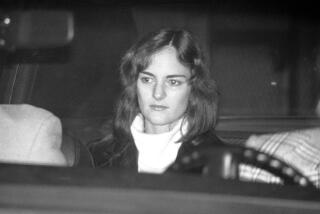Hearst-Davies an ill-fated duo
- Share via
He created one of the great film classics of all time, but Orson Welles also did a major disservice to actress Marion Davies with “Citizen Kane.”
The writer/director/star’s landmark 1941 film is a thinly veiled and highly critical account of newspaper tycoon William Randolph Hearst. Welles was also unsparing in his depiction of his protagonist Charles Foster Kane’s second wife, Susan Alexander -- a boozy, suicidal and hopelessly untalented would-be opera singer.
Because Hearst and Davies were lovers for over three decades, everyone has assumed in light of “Kane” that Davies was exactly like Alexander. The truth couldn’t be further from the fiction. In fact, Welles ended up writing the preface to Davies’ autobiography, a mea culpa of sorts for the damage he did her.
Bright, vivacious -- she was once described as the bubbles in Champagne -- Davies was a crackerjack comedic actress. Despite that, Hearst loved to see her in lugubrious costume dramas, yet Davies managed to rise above the frills and the fray.
In conjunction with its current “Hearst the Collector” exhibition, the Los Angeles County Museum of Art this weekend kicks off a series, “William Hearst, Marion Davies and Hollywood,” which features several of Davies’ films that Hearst produced under his Cosmopolitan Productions banner as well as Hearst newsreels. (And yes, “Citizen Kane” will be shown).
“I don’t think she was ambitious personally. I think she saw her career more as a way to have fun,” said Nancy Loe, assistant dean at Cal Poly San Luis Obispo, who is in charge of the school’s Julia Morgan archive. (Morgan was the architect of Hearst Castle in San Simeon and the Los Angeles Herald-Examiner building, among many others.)
The one aspect of Welles’ depiction of Susan Alexander that matched Davies was her battle with alcoholism.
“But I think one of the things people lose sight of between the portrayal in ‘Citizen Kane’ and certainly the stories of her alcoholism was that she was a great philanthropist,” Loe noted. “In many ways more of a philanthropist than Hearst.”
Davies, who was born in 1897, made her debut as a Broadway chorus girl in 1910 in “The Blue Bird” and created a splash in 1917’s “The Ziegfeld Follies.” She met Hearst that year and became his mistress for the next 34 years. The two made movies together until she retired from screen in 1937. Davies died of cancer in 1961.
Despite the fact that they loved each other, there was a dark side to their relationship. Davies had a bell system established on set once that would let her know when Hearst was arriving. She had dalliances with the likes of Charlie Chaplin and Leslie Howard, and Hearst was known to have had detectives follow her.
Film historian Cari Beauchamp will be introducing the Nov. 28 double bill, 1925’s “Zander the Great” and 1932’s “Blondie of the Follies.”
“It’s one of my favorite silents,” says Beauchamp of “Zander.” “It shows Marion free of those lavish costumes, heavy headdresses and ornate sets that Hearst loved her in. She has an opening scene where she’s in pigtails with her freckles showing, a lollipop and doing a bicycle ride, which is reminiscent of Mack Sennett.”
Who knows what her career would have been like without Hearst controlling her? “The good news is that she was with William Randolph Hearst, and the bad news is she was with William Randolph Hearst,” says Beauchamp. “So we have to take her as we have her. Fortunately, we are able to bask in the glory of her films.”
--
--
‘William Hearst, Marion Davies and Hollywood’
Where: Leo S. Bing Theater, Los Angeles County Museum of Art, 5905 Wilshire Blvd.
When: Today: “Show People,” 7:30 p.m.; “The Patsy,” 9 p.m.; Saturday: “Hearst Metrotone News,” 7: 30 p.m.; “Gabriel Over the White House,” 9:15 p.m.; Nov. 25: “Peg O’ My Heart,” 1 p.m.; Nov. 28: “Zander the Great,” 7:30 p.m.; “Blondie of the Follies,” 9:15 p.m.; Nov. 29: “The Battle Over Citizen Kane,” 5 p.m. (free); “Citizen Kane,” 7:30 p.m.
Price: Admission is $7 for LACMA members, seniors 62 and older and students with an ID; $10 for nonmembers. Tuesday matinees are $1 for seniors and $2 for general admission.
Contact: For information go to www.lacma.org.
More to Read
Only good movies
Get the Indie Focus newsletter, Mark Olsen's weekly guide to the world of cinema.
You may occasionally receive promotional content from the Los Angeles Times.











